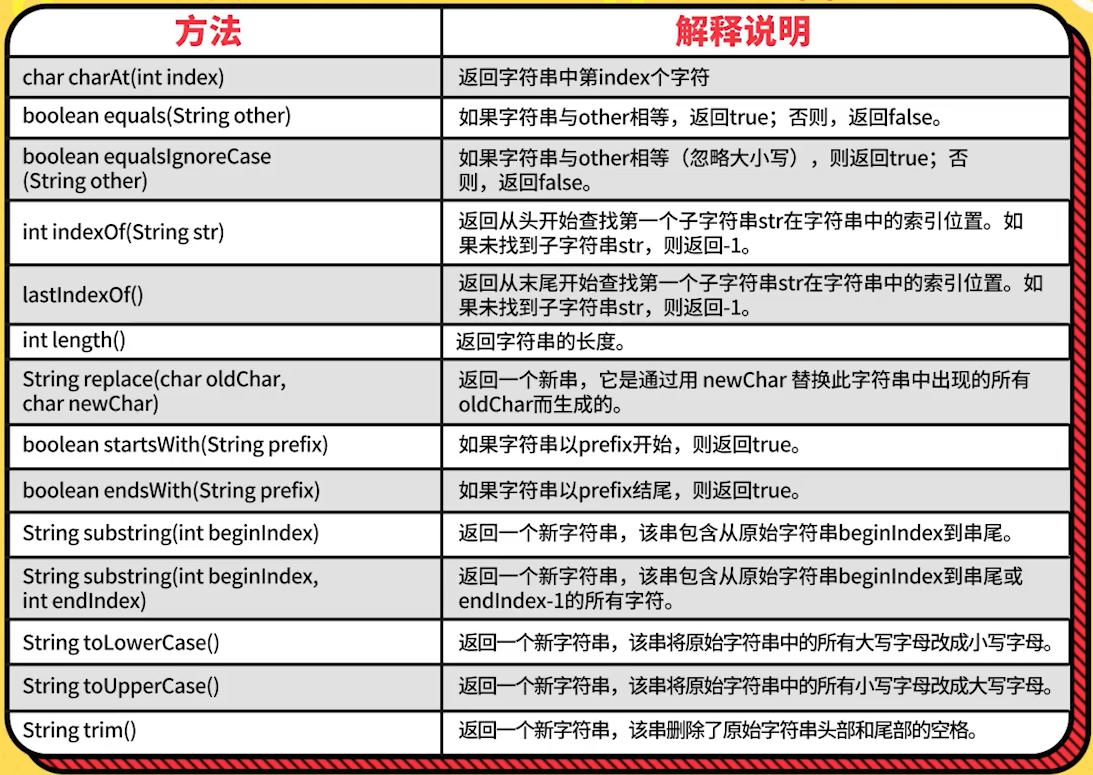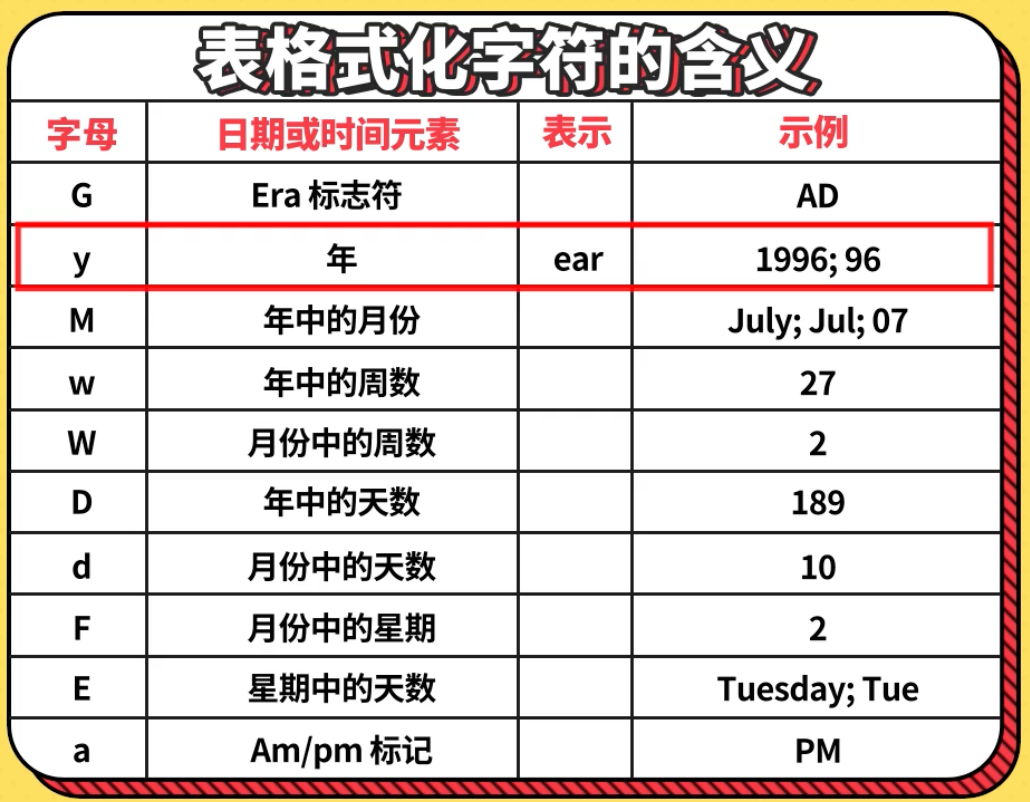String类
基础概念
- jeeString类又称作不可变字符序列
- String类位于java.lang包中,java程序默认导入java.lang包下的所有类
- Java字符串就是Unicode字符序列,例如字符串”Java”就是4个Unicode字符”J”、”a”、”v”、”a”组成的
- Java没有内置的字符串类型,而是在标准Java类库中提供了一个预定义的类String,每个双引号扩展起来的字符串都是String类的一个实例
- 双引号引起来的字符串均存放在字符串常量池中 ```java String s1 = “abc”; // 字符串常量,放置于字符串常量池 String s2 = new String(“abc”); // 建立一个新的字符串对象 String s3 = “abc”; String s3 = “aBC”;
System.out.println(s1 == s2); // false System.out.println(s2 == s3); // true System.out.println(s1.equals(s3)); // true 判断字符串的值是否相等 System.out.println(s1.equalsIgnoreCase(s4)); // true 判断字符串忽略大小写值相等
<a name="tozJM"></a>## String类方法列表<a name="w51Pw"></a># StringBuffer、StringBuilder类<a name="Lpg9w"></a>## 基础概念| **String** | **StringBuffer** | **StringBuilder** || --- | --- | --- || 不可变字符序列 | 可变字符序列 | 可变字符序列 || | 线程安全,做线程同步检查,效率较低 | 线程不安全,不做线程同步检查,因此效率高。建议使用该类。 |<a name="I8GwU"></a>## 常用方法- StringBuilder与StringBuffer的常用方法是一致的- append("a"),追加- insert(0,"a"),插入- delete(0,2),删除- deleteCharAt(0),删除- reverse(),逆序<a name="vbvyV"></a># 包装类<a name="QyTBr"></a>## 八种基本数据类型的包装类| 基本数据类型 | byte | boolean | short | char | int | long | float | double || --- | --- | --- | --- | --- | --- | --- | --- | --- || 包装类 | Byte | Boolean | Short | Char | **Integer** | Long | Float | Double |<a name="Wbbyw"></a>## 包装类的使用方式```java// 基本数据类型转化成Integer对象Integer int1 = Integer.valueOf(100);// 包装类对象转成基本数据类型int int2 = int1.intValue();long long1 = int1.longValue();// 字符串转Integer对象Integer int3 = Integer.parseInt("321");// 类型最大数System.out.println("int能表示的最大整数:" + Integer.MAX_VALUE);
自动装箱和自动拆箱
Integer a = 100; // 自动装箱,编译器完成正常类型转换操作int b = a; // 自动拆箱
整型、char类型所对应的包装类在自动装箱时,对于-128到127之间的值会进行缓存处理,以提高效率
Integer a = 100;Integer b = Integer.valueOf(100);System.out.println(a == b); // true a b 是同一个类,由IntegerCache类处理Integer c = 300;Integer d = Integer.valueOf(300);System.out.println(c == d); // false c d 不是一个类
源码解读Integer类
```java public class MyInteger { public static final int LOW_VALUE = -128; public static final int MAX_VALUE = 127;
private int value; private static MyInteger[] integerCache = new MyInteger[256];
static {
for (int i = MyInteger.LOW_VALUE; i <= MyInteger.MAX_VALUE; i++) {integerCache[i + (-MyInteger.LOW_VALUE)] = new MyInteger(i);}
}
public static MyInteger valueOf(int val){
if(val>= MyInteger.LOW_VALUE && val<= MyInteger.MAX_VALUE){return integerCache[val + (-MyInteger.LOW_VALUE)];}else {return new MyInteger(val);}
}
public int intValue(){
return value;
}
public String toString(){
return value + "";
}
private MyInteger(int val){
value = val;
}
public static void main(String[] args) {MyInteger a = MyInteger.valueOf(100);MyInteger b = MyInteger.valueOf(100);System.out.println(a == b);MyInteger c = MyInteger.valueOf(300);MyInteger d = MyInteger.valueOf(300);System.out.println(c == d);}
}
<a name="H9uE9"></a># 时间相关类<a name="XuNJG"></a>## Date```javapublic static void testDate(){// 返回当前毫秒数long nowMillis = System.currentTimeMillis();Date d1 = new Date();Date d2 = new Date(1000L * 3600 * 24 * 100);}
DateFormat
时间和字符串之间互相转换
public static void testDateFormat(){// 日期对象转字符串DateFormat df = new SimpleDateFormat("yyyy-MM-dd hh:mm:ss");Date d2 = new Date(1000L * 3600 * 24 * 100);Sting strD2 = df.format(d2);// 字符串转日期对象Sting strD3 = "2049-10-1 10:10:20";Date d3 = df.parse(str3);// 获取当前时间是当年的第几天Dateformat df2 = new SimpleDateFormat("D");String theDay = df2.format(d2);}
Calendar
public static void testCalendar(){// 月份 0-11一月到十二月 星期1-7 周日到周六Calendar calendar = new GregorianCalendar(1989,3,14,8,8,8);int year = calendar.get(Calendar.YEAR);int month = calendar.get(Calendar.MONTH)calendar.set(Calendar.YEAR,2017)// 返回的日期对象Date d1 = calendar.getTime();// 返回的毫米数long millis1 = calendar.getTimeInMillis();// 日期计算,增加1000天calendar.add(Calendar.DATE,1000)// 日期计算,减少30年calendar.add(Calendar.YEAR,30)}


